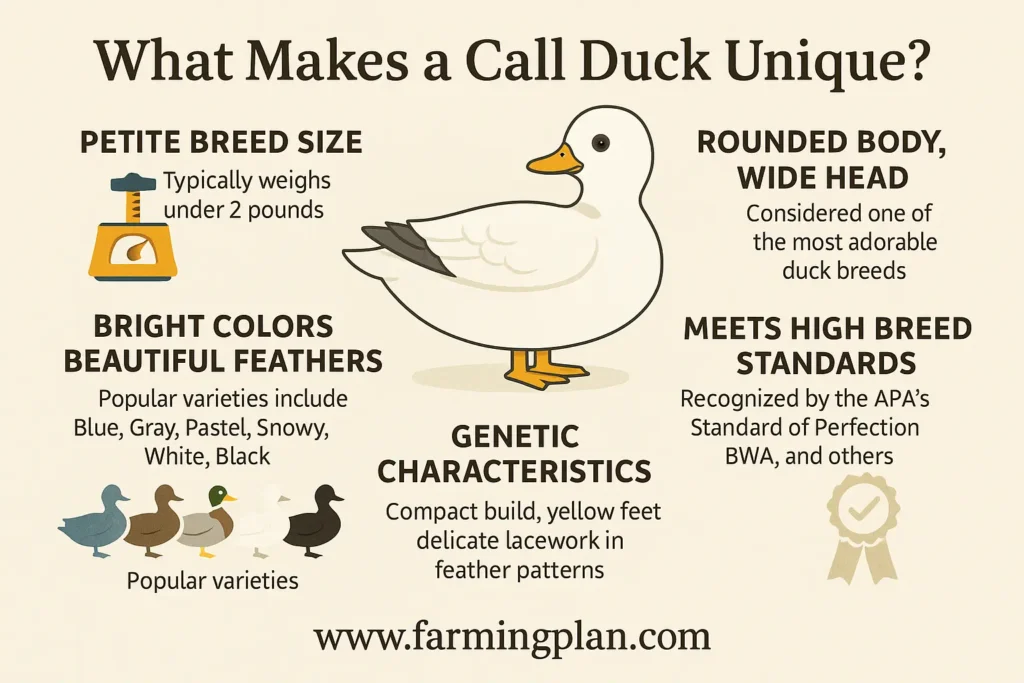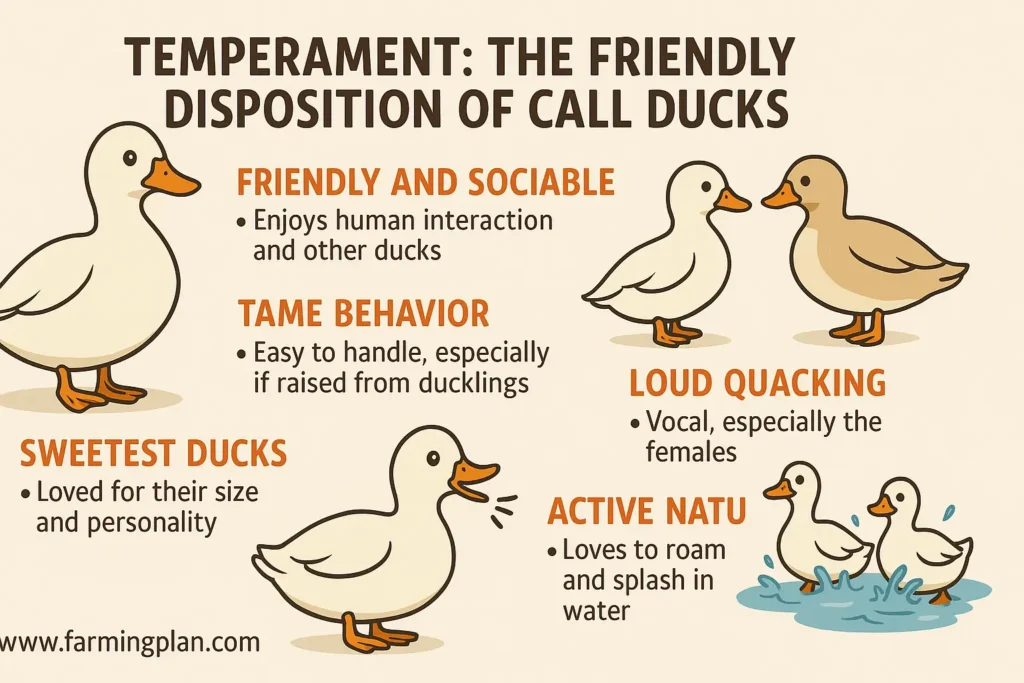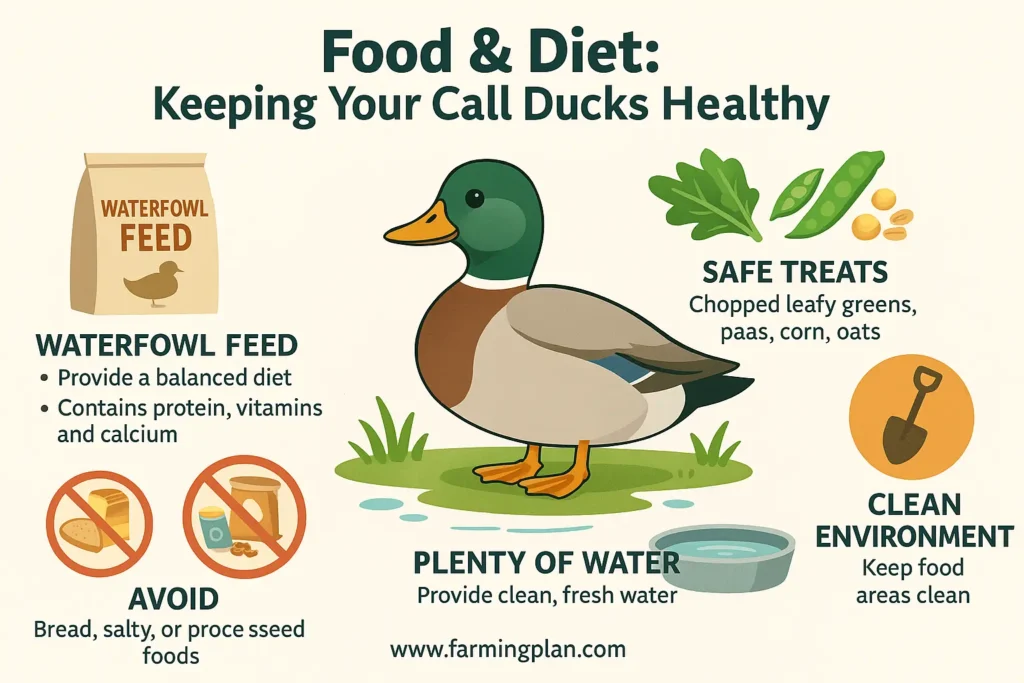If you’re looking for a duck breed that’s small, sociable, and full of personality, the Call Duck is hard to beat. Known for its loud quack, cute appearance, and friendly disposition, this petite breed has become a favorite among pet owners, breeders, and hobby farmers. With its compact size, wide head, and an array of beautiful color varieties, the Call Duck easily wins hearts. Whether you’re drawn to their elegant presence or just love watching them waddle around in flocks, Call Ducks offer a perfect blend of beauty and charm. In this guide, we’ll explore everything you need to know about this lovable breed—from its origin and care tips to finding the right one for your home or farm.

History & Origin: Tracing the Roots of Call Ducks
The Call Duck has a fascinating history that dates back to the 18th century. Originally bred in the Netherlands, these ducks served a very specific purpose: they were used as decoy ducks. Hunters relied on their distinctive quack to lure wild waterfowl into traps. Their loud calls would attract flocks of wild ducks, making hunting much easier.

Call Ducks share many mallard characteristics, which makes sense since they are believed to be descendants of domestic mallards. Over time, they spread across Europe and gained popularity in Britain and America, especially for their use in hunting and later as show birds.
Though their exact origins are still debated, one thing is certain—they’ve earned their place in the world of domestic waterfowl. Today, Call Ducks are valued more for their attractive appearance, tame behavior, and friendly nature than for their original purpose.
Their transformation from effective decoys to beloved backyard pets is a perfect example of how humans and animals can evolve together over time.
Characteristics: What Makes a Call Duck Unique?
The Call Duck is known for its petite breed size, rounded body, and wide head, making it one of the most adorable duck breeds you’ll ever see. It stands out not just for its looks but also for its lively personality and loud voice.

Call Ducks typically weigh under 2 pounds and have a compact size that’s easy to manage. Their colored body comes in a variety of stunning shades. Popular color varieties include Blue Call Ducks, Gray Call Ducks, Pastel, Snowy, White, and Black Call Ducks. Some display a green head or brown head, while others show off soft, slate-blue plumage, white feathers, or even black plumage with a subtle shine. These bright colors and beautiful feathers make them favorites in exhibitions.
Feather color can also shift slightly between eclipse plumage (non-breeding season) and nuptial plumage (breeding season). Though most maintain an immaculate appearance, some breeders notice minimal variations in hue, such as a lighter shade or a subtle bluish-gray hue on certain birds.
Call Ducks meet high breed standards set by associations like the American Poultry Association’s Standard of Perfection and the British Waterfowl Association. These guidelines ensure the birds maintain their elegant presence and distinct characteristics across generations.
Their genetic characteristics, including their compact build, yellow feet, and delicate lacework in feather patterns, make them not just beautiful birds, but also fascinating examples of selective breeding done right.
Temperament: The Friendly Disposition of Call Ducks
The Call Duck isn’t just cute—it’s also incredibly friendly and sociable. This breed loves to be around people and other ducks, making it a top choice for families, pet duck ownership, and even classroom pets. If you’re looking for a duck that enjoys human interaction and won’t shy away from attention, Call Ducks are perfect.

Their sociable nature shines when they live in small flocks or spend time with fellow Call Ducks. They’re naturally curious, always exploring, and often follow their owners around like little feathered friends. Their tame behavior makes them easy to handle, especially if you raise them from ducklings.
Because of their active nature, they love to roam and splash in water, so make sure they have space to move around. Many owners say Call Ducks are the sweetest ducks they’ve ever had—not just for their size but for their personality.
You’ll also notice their loud quacking, especially from the females. While it might seem noisy at times, it’s one of the traits that give them so much character. Their voice isn’t just for fun—it’s part of what made them effective decoys in the past.
Whether you keep them indoors as a house duck or outside with a small flock, Call Ducks bring joy, charm, and a lot of noise to any backyard or home.
Food & Diet: Keeping Your Call Ducks Healthy
Feeding your Call Duck the right diet is key to keeping it healthy and happy. These ducks might be small, but they’re full of energy and need balanced nutrition to stay in perfect condition.

Start with a high-quality waterfowl feed or a non-medicated chick starter when they’re young. As they grow, switch to a grower or layer feed depending on their age and purpose especially if you’re raising calls duck eggs. Make sure the feed contains the right mix of protein, vitamins, and calcium to support healthy Call Ducklings and strong eggshells.
You can also give them safe treats like chopped leafy greens, peas, corn, and oats. They love hunting for bugs, which adds natural protein to their diet. Just avoid giving them bread, salty snacks, or anything processed—these can cause serious health problems.
Always provide clean, fresh water. Call Ducks use water not only to drink but also to wash down their food and keep their nostrils clean. Without proper access to water, they may develop issues with digestion and hygiene.
To ensure comfortable conditions, clean their feeding areas often and remove leftover food that might spoil. Good feeding habits go a long way in raising healthy ducks that are active, social, and full of life.
Read More: Adorable Duck Breeds You’ll Love
Uses & Purpose: More Than Just a Cute Pet
While many people raise the Call Duck for its charming looks and friendly nature, this little bird has served several important roles over the years. Its loud, high-pitched quack made it an ideal decoy duck for hunters during the 18th century. Hunters would place these ducks near traps to lure wild waterfowl in, using their calls as a natural magnet for mallard ducks and other species.
Today, Call Ducks are more commonly kept as pets, show birds, or part of hobby farms. Their petite breed and attractive appearance make them ideal for exhibition standards and poultry shows. They come in a variety of color schemes, and judges look for traits like black appearance, white plumage, or a balanced colored body that aligns with the Standard of Perfection set by the American Poultry Association.
Some breeders keep them for calls duck eggs, though they are not known for heavy egg production. Their eggs are small, and while edible, they’re more often used for hatching additional ducks than for food.
Thanks to their tame behavior and friendly disposition, they’re also used in schools and petting zoos to teach children about birds and domestic waterfowl. Their sociable nature and ability to bond with humans make them a great choice for pet duck ownership, even in suburban backyards.
Whether you’re a breeder, a hobbyist, or a first-time duck owner, the Call Duck offers the perfect blend of beauty, behavior, and purpose.
Read More: Saxony Duck Advantage: Healthier, Happier,& More Profitable
Special Features: Unique Traits That Set Call Ducks Apart
The Call Duck may be small, but it’s full of standout qualities that make it one of the most loved duck breeds around. Its most famous feature? That unmistakable loud quacking. Despite its size, this duck has a powerful voice that once made it perfect for calling in wild ducks during hunts.
Call Ducks are also known for their immaculate appearance and delicate lacework in feather patterns. Their feathers can show stunning shades—like a soft brown, a subtle bluish-gray hue, or a bright metallic color—that vary by type. Some birds even have muted feathering consisting of layered tones, while others proudly show off white feathers, gray plumage, or a rich black appearance.
Many varieties are parti-colored birds, with a mix of colors that give them a unique look. Breeds like Blue Call Ducks or Pastel Call Ducks are especially prized for their elegant presence and unusual shades. Others, like the Metzer Farms White Calls, are valued for their mint condition appearance and balanced coloring.
Another rare quality is their compact size paired with their ability to stay active and social. Their green head or brown head, yellow feet, and cheerful expression give them a look that’s as lovable as their personality.
Because of their limited availability, especially in rarer colors, some Call Ducks are considered collector’s birds. Their beautiful feathers, genetic characteristics, and strong personality make them popular among those who show birds or seek rare colored varieties.
These tiny birds pack a big impression, turning every walk in the backyard into a little parade of style, sound, and charm.
Read More: Magpie Duck: British Breed of Domestic Duck
Health Issues & Prevention: Keep Your Call Ducks Thriving
Keeping your Call Duck healthy is easier when you know what to watch for. Like other domestic duck breeds, they can face a few health problems, but most are preventable with the right care and attention to comfortable conditions.
One common issue is wet or dirty bedding, which can lead to foot problems or respiratory infections. Call Ducks are low to the ground, so they’re more likely to get dirty or chilled if their living area isn’t clean and dry. Make sure their coop has good airflow and fresh straw or shavings.
They may also suffer from color issues or muted feathering if their diet lacks nutrients. Keep them on a high-quality feed, and avoid giving too many treats that don’t support feather health. For ducks used in shows, maintain a diet that supports their beautiful feathers and overall immaculate appearance.
Genetic problems can appear in some colored varieties, especially those bred for looks alone. Choosing ducks from reputable sources like Metzer Farms ensures better genetic characteristics and lower risk of inherited health problems.
Parasites like mites or lice can affect any bird, so check their feathers regularly. Ducks who bathe in clean water and have space to preen usually stay free from pests. If you see signs like feather loss, excessive scratching, or tiredness, it’s time to act fast with treatment.
Keep vaccinations and vet check-ups on schedule, especially if you’re raising healthy Call Ducklings. Watch out for signs like limping, droopy wings, or a quiet duck that’s usually loud.
“Small in Size, Big in Personality—The Call Duck Will Steal Your Heart!”
Pet Owner Care Guide: Raising a Happy Call Duck Step-by-Step
Raising a Call Duck requires attention to detail and a commitment to providing the right environment. With the right care, your Call Duck can thrive, offering years of companionship and entertainment. Here’s a simple, step-by-step guide to ensure your duck is happy, healthy, and well-adjusted.
Step 1: Preparing the Space
Start by setting up a safe and comfortable living space for your duck. Call Ducks do well in a small coop, but they need plenty of space to move around. Ensure they have a dry, clean area with fresh bedding (straw or shavings) to avoid foot problems. Ducks like to bathe, so include a shallow kiddie pool or water dish they can dip their heads into for cleaning.
Step 2: Choosing Your Ducklings
When selecting your Call Ducklings, choose a reputable breeder who offers healthy Call Ducklings and follows proper breeding standards. If you’re looking for rare color varieties, like Blue Call Ducks or Pastel Call Ducks, confirm that the breeder specializes in these colors to ensure the ducklings are well-bred and have strong genetic characteristics.
Step 3: Feeding Schedule
Call Ducks are active ducks, and they need a diet that fuels their energy. Start with a high-quality starter feed for ducklings, transitioning to grower or layer feed as they age. Supplement their diet with safe veggies like leafy greens, peas, and corn. Be sure they have access to clean, fresh water at all times—this is vital for digestion and cleanliness.
Step 4: Cleaning Routine
Maintain a clean environment to avoid the buildup of bacteria and pests. Change their bedding regularly, and wash their water dish or bathing area daily. Keep an eye out for any signs of illness, such as a droopy appearance or lack of activity. Routine cleaning helps keep your ducks in mint condition and ensures they stay healthy.
Step 5: Handling and Socializing
Since Call Ducks are naturally sociable, it’s important to interact with them regularly. Start by gently handling them as ducklings to build trust. They’re very tame ducks and will enjoy being around you, whether it’s during feeding time or just for some extra attention. Their friendly disposition means they’ll often follow you around and enjoy being part of the action.
Step 6: Winter and Summer Care
Call Ducks are hardy, but extreme weather conditions can cause stress. In colder months, make sure their living area is well-insulated and protected from drafts. In the summer, provide plenty of shade and water to help them stay cool. Regular access to water is especially important during hot weather as it helps keep their bodies regulated.
FAQ
What are Call Ducks known for?
Call Ducks are renowned for their distinctive, high-pitched quacking, which was historically used to attract wild ducks into traps. Today, they are primarily kept as ornamental pets and exhibition birds due to their charming appearance and sociable nature.
How many eggs do Call Ducks lay annually?
Female Call Ducks typically lay between 50 and 150 small, pale green eggs per year. Their egg production is relatively low compared to other duck breeds, and they are seasonal layers, usually laying during the spring.
Are Call Ducks suitable for small backyards?
Yes, Call Ducks are well-suited for small backyards due to their compact size and friendly disposition. However, they are active and noisy, so it’s important to ensure they have a secure environment and that noise levels are acceptable in your area.
Do Call Ducks make good pets?
Absolutely! Call Ducks are known for their sociable and affectionate nature. They enjoy human interaction and can become quite tame, making them delightful companions for families and individuals alike.
What are common health concerns for Call Ducks?
Common health issues for Call Ducks include respiratory infections, foot problems from wet bedding, and parasites like mites or lice. Regular cleaning, proper diet, and routine health checks can help prevent these issues and keep your ducks healthy.
Conclusion
The Call Duck is a small, sociable breed known for its distinctive quack and charming appearance. Originally used as decoys in hunting, they are now cherished as pets and exhibition birds. With proper care, including a balanced diet, clean living conditions, and regular health checks, Call Ducks can thrive in small backyards. Their friendly disposition and active nature make them delightful companions, though potential owners should be mindful of their noise levels and need for secure enclosures.

